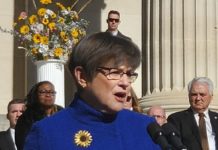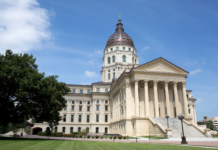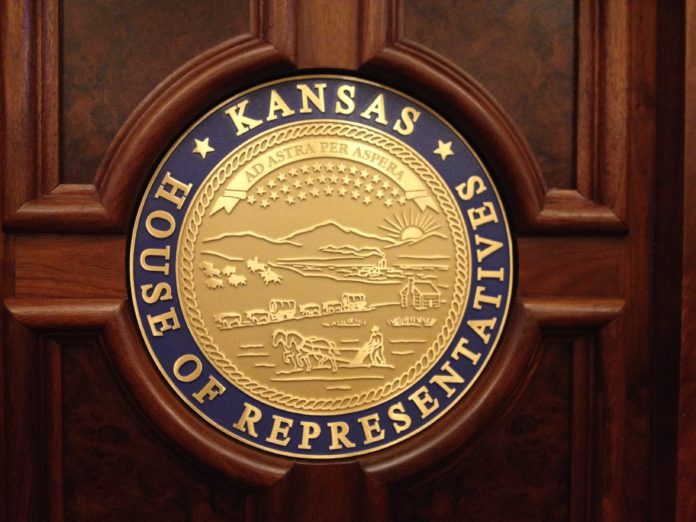(Updated to include comment from House speaker pro tem and reflect new number of Democrats voting against the bill with links to vote, bill and fiscal note)
The Kansas House soundly turned back Gov. Laura Kelly’s plan for restructuring retirement system payments that she said would help bring fiscal stability but that critics said would cost the state billions.
The House voted 87-36 to reject the plan, which called for lowering the state’s contributions into the retirement system and stretching out the long-term payment schedule for 30 years. Four Democrats voted against the bill, including one who wanted it to include cost-of-living adjustments.
It was the first political defeat at the Capitol for the newly elected Democratic governor since taking office last month.
“I’ve offered commonsense solution after solution in addition to working in good faith to engage legislators,” Kelly said in a statement.
“I look forward to their ideas to balance the budget and moving forward — while also meeting all our other obligations like schools and highways,” she said. “It is time to stop playing political games and get to work finding solutions for families.”
Republican state Rep. Blaine Finch, the House speaker pro tem, said the chamber wanted to force a vote on the proposal earlier rather than later since it’s one of the foundations of the governor’s budget.
“I think it was pretty clear that a majority of this body was not comfortable with what the governor had proposed,” Finch said.
“They weren’t comfortable adding $7.4 billion in spending. They weren’t comfortable kicking this obligation down the road 15 years and they weren’t comfortable saddling our children and our children’s children with debt to pay for today’s operations.”
The Kelly administration said failure to get the plan approved would eat away at the state’s balance at the end of the fiscal year, which was projected to be nearly $700 million next year.
The administration’s floor leaders in the House weren’t alarmed by the plan’s immediate failure to pass, although they say it raises long-term concerns about the state’s ability to make retirement system payments.
“The governor has the largest ending balance in two decades in her budget,” said Democratic state Rep. Brett Parker, who carried the reamortization bill on the House floor.
“We’re just fine for this year, but it is a long-term vision of making sure that it’s not just paying in this year and it’s not just meeting our obligations this year but over the life of the program.”
Parker said Thursday’s vote sent a message that Republicans “are more interested in playing political games than actually putting together a budget that works.”
Finch said the House needed to get an idea of whether the governor’s plan would get any traction.
“I think we needed to test it earlier rather than later to determine whether we need to build a budget in that direction or build it in a different way,” Finch said. “You can be sure when we’re done we’ll have a budget that balances.”
Currently, most of the unfunded pension liability in the state/school part of the pension fund would be covered by 2033.
Under Kelly’s plan, the state would stretch out payments into the pension system so the unfunded liability wouldn’t be covered until sometime between 2048 and 2050. Retiree benefits wouldn’t be affected.
The plan would have freed up about $160 million that could have been redirected into other areas, such as public education, corrections, child welfare and Medicaid expansion.
However, critics noted that the new payment schedule would have cost the state $7.4 billion more in interest over the life of the new payment schedule.
They said this was the wrong time to refinance the retirement system since the state was so close to covering most of its unfunded liability.
“We are so close for the first time since I’ve been watching the pension (system) to tripping that point of reducing the liability,” Republican state Rep. Steven Johnson told the House insurance committee this week.
As the state reduces interest costs stemming from the pension fund, he said, it means more money for government services.
“Those are dollars you not only get to use now,” he said, “but every day into the future once that interest cost is eliminated.”
The Kelly administration touted the plan as a way of managing retirement system payments while stabilizing the state budget.
The govenor said the plan ensured the state would make its contributions to the pension system going forward.
The retirement system payment already scheduled for 2020 is $663 million, increasing to $688 million the following year and eventually reaching $923 million in 2035. Kelly’s plan was to bring those payments down so they’re more affordable.
By comparison, the payments would have been closer to a little more than $500 million under the governor’s plan in 2020 and 2021. In 2035, the payment would have been about $650 million under her plan.
















